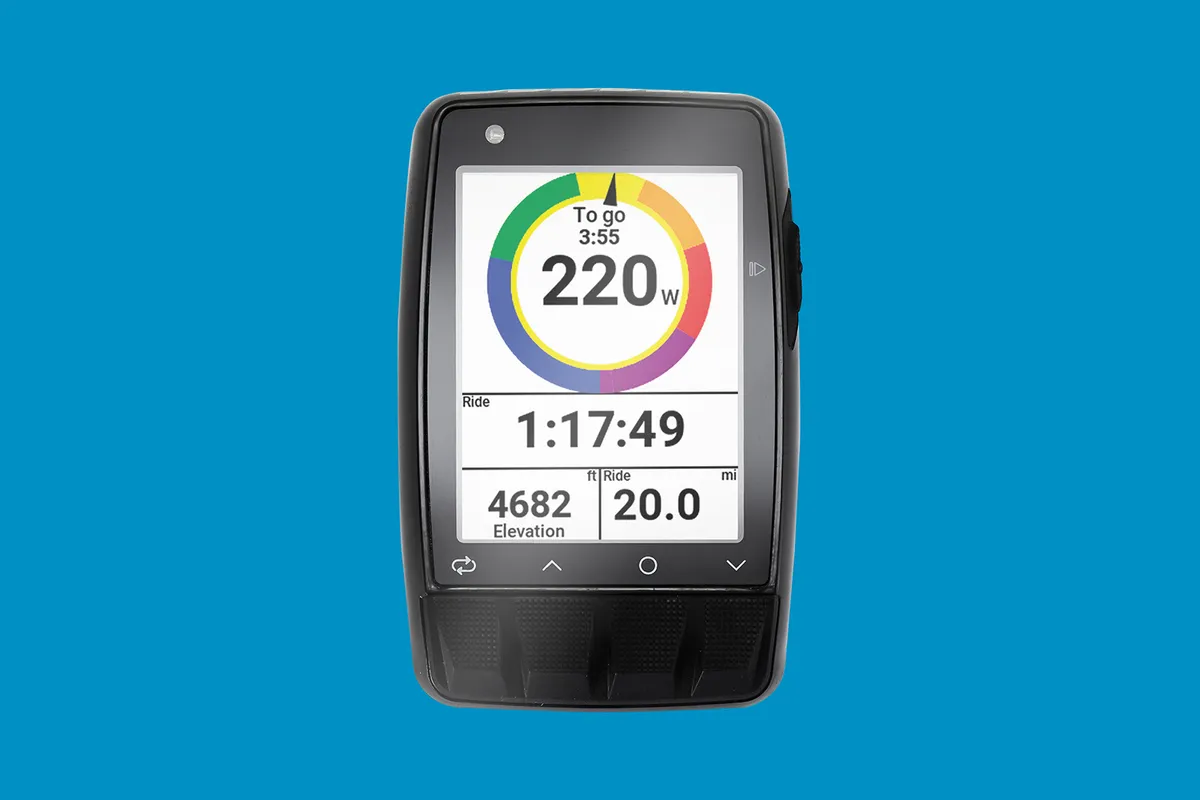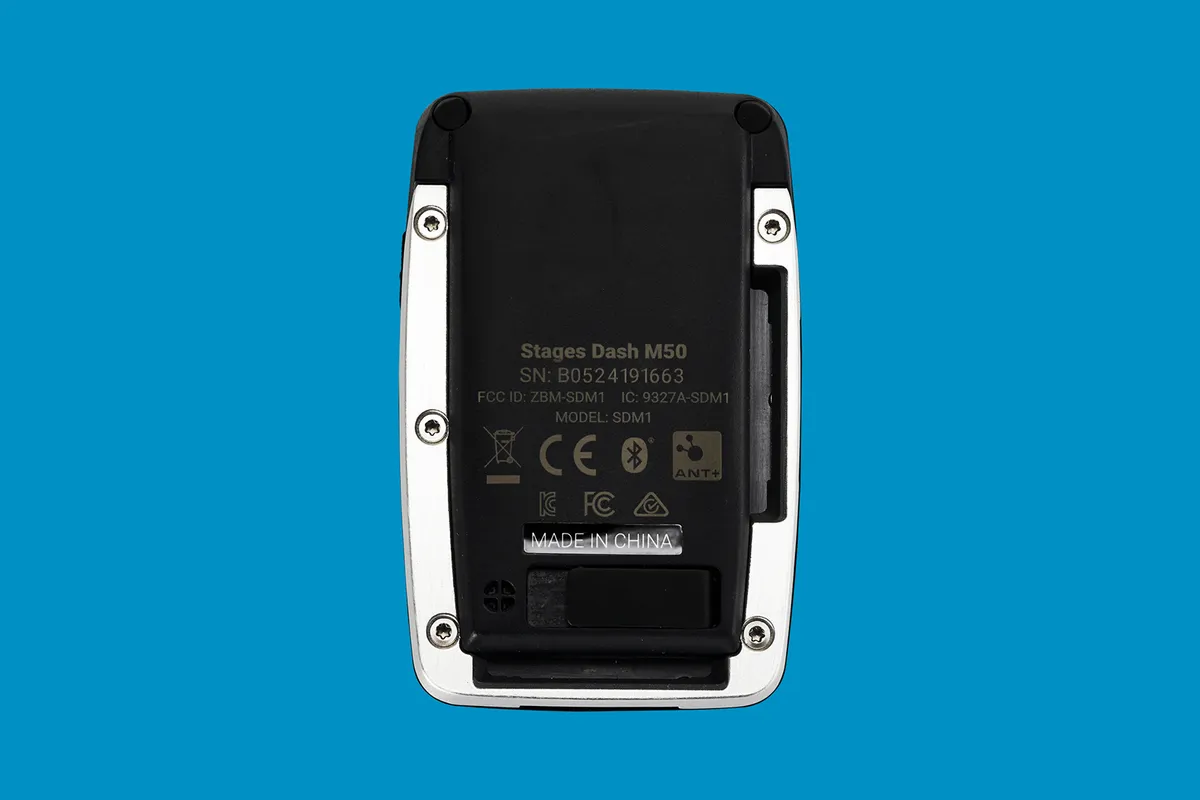In use, Stage's Dash M50 feels similar to units by Wahoo in that all the major functions are controlled by buttons, combined with a small but brightly backlit screen, itself a quality Everbrite unit.
The screen is seriously bright and the auto-adjustment on the brightness is impressively quick, and riding into a tunnel the head unit shined brightly (just before it lost GPS signal).
The M50 is full colour and Stages presents the data and a detailed map well, but it lacks the detail of something like a Garmin. However, when compared to some units from Lezyne and Bryton , it looks positively packed with info.
Stages Dash M50 size
The downside of the Dash’s size is that with a lot of information to show, the pages can be hard to read at a glance. Also, tuning the pages still requires linking via USB to a laptop.
If the Dash had the same setup as Wahoo's GPS units via an app, or head unit like Garmin, it would be a more user-friendly experience. That said, if you run the Dash in landscape mode, it makes up a little for the size especially when looking at page options that feature graphs.
The unit itself can be orientated in either portrait or landscape, and the clip in the mount has fittings on the unit’s base and flank to match. The mount itself is pretty stiff to click into place and, for the first few rides, I was never quite sure if the unit was properly secured.
Stages Dash M50 setup
Initial setup can be a little convoluted because you need to download apps to your phone and to your desktop too. Then it’s a case of accessing the Stages Link web page and ‘authorising’ the unit to your account.
Compared to Garmin Connect’s relative simplicity and the slick, sharp setup of Wahoo it’s all a bit well, Windows XP…
This is a shame because Stages, with its power meter background, offers a huge wealth of data analysis – especially if you sign up for Stages Link Premium, which adds in Stages-curated data analytics, unlimited training plans within a seasonal planner, and a workout library and workout creator.
Talking of which, the workouts cover everything from primers, with around seven hours a week of riding, right up to training for a full Ironman triathlon. The available plans do tend to have more of a bias towards triathlon more than anything else, but as you can create your own (or use plans from dedicated coaching sites) that’s not too much of a concern.
Stages Dash M50 data and connection
The data is displayed in clear graphs featuring primary colours. They’re easy to understand and provide a great inroad for those wanting to seriously train with power and heart rate.
Connection rates for the sensors were good, and power from both SRAM and Shimano units was found quickly and held stable, as were both types of heart-rate monitor – it’s got both Bluetooth and ANT+ pretty well covered.

It supports power, heart rate, cadence and speed, but it wouldn’t connect to the gearing info on SRAM or Shimano. However, Stages promises that will come in a later update.
The GPS pick-up activated in just over 50 seconds after the unit had started up (which does take a minute or two). Once there is a GPS signal, the mapping loads tiles from your immediate area. This means, overall, the M50 does take a little while to kick into gear, which can be frustrating if you’re eager to get going on a ride.
Stages Dash M50 maps
Out and about the map works well and is easy to understand, although zooming in and out is pretty convoluted because it requires multiple button presses, which is a distraction when riding.
The Dash also seemed to have a bit of trouble keeping stable when it comes to gradients, and kept drifting between minus and plus gradients up to around 7 per cent, even where it was known that the road is predominantly flat and being of a gradient between -/+1 per cent – however, a later firmware update should have improved this.
The unit itself syncs with your phone and the Strava app via Bluetooth, and you can hardwire it to your laptop via the USB port. There is no WiFi support.
Currently, there is no Strava live segment support (due to issues with licensing payments required by Strava) either – although you can use the Dash to upload to Strava because the M50 will take .fit,.gpx and .tcx files (and that’s pretty much every type of route you could need).
Stages claims battery life is up to 20 hours, but I found it to be around 11 hours. This is still impressive from a unit where the screen brightness is so good that it could double up as a light (at a pinch).
Stages Dash M50 overall
The Stages Dash M50 has a lot of promise. It performs well enough and Stages is brilliant at well-structured training programs and presenting data. The M50 does however need a few tweaks.
The wandering gradient metric is a worry, but is hopefully now less of an issue, and the reliance on USB to connect to a laptop in order to make changes to the setup is just a bit basic. However, Stages says that page and data-field adjustment from the app is coming soon.
The head unit is very well put together. It’s tough, with good waterproofing and shock-resistance, plus the screen is also excellent. Over the test period there were two firmware updates both of which improved performance, and if Stages delivers the updates promised it’ll be a serious rival to Wahoo’s Bolt and Roam.
How good is the Stages Dash M50 for mountain biking?
The map on the Stages Dash M50 has good detail and features bridleways, cycle routes and paths, and forest tracks. You can scroll the map around without a pre-programmed route, so it’s possible to use it as a true navigation tool.
However, problems start to rear their heads when you want to scroll the map – doing so requires a lot of button pushes, making it virtually impossible to work while on the move. The buttons are also very stiff, so device operation is trickier still.

If you top off the awkward-to-use features with a lack of place names and important information on the on-device map (although it does seem to include some points of interest such as pubs), and a lack of off-course rerouting, then it can be frustrating to use.
It’s only supplied with a 31.8mm out-front mount, so if you have 35mm bars, don’t expect to use the device right out of the box without making an additional purchase.
Although it’s not entirely unsuitable for use off road, the Stages Dash M50 doesn’t have especially intuitive operation and lacks certain features. We wouldn’t recommend buying it if you’re going to be using it for off-road applications only.
Product
| Brand | stages_cycling |
| Price | 239.00 EUR,209.00 GBP,250.00 USD |
| Weight | 95.2000, GRAM () - |
Features
| br_screenType | everbritelcdcolourscreen |
| Features | In the box: |
| br_dimensions | 48mm x 75mm x 23mm |
| br_batteryLife | 20 hours (claimed) |
| br_waterResistance | IPX7 |
| br_screenDimensions | 46mm x 35mm |
